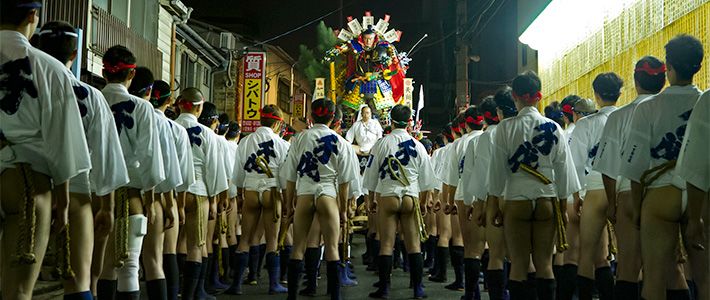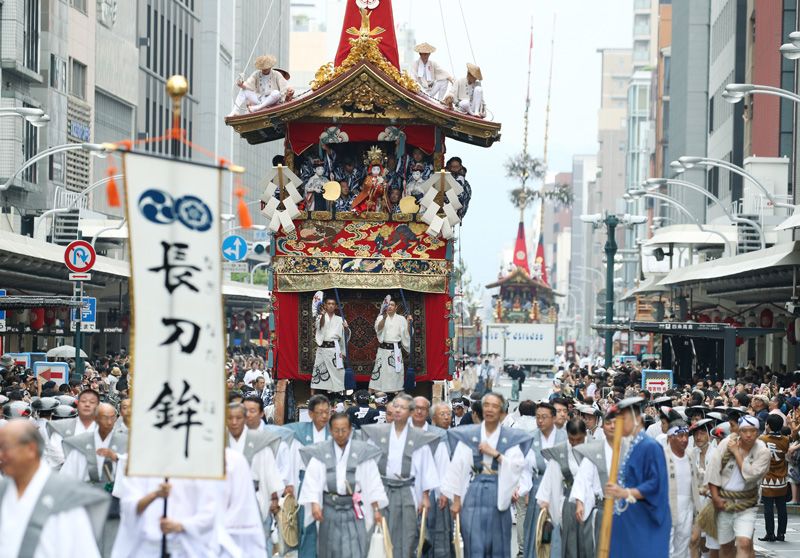
Float Festivals Inscribed on UNESCO Intangible Heritage List
Culture- English
- 日本語
- 简体字
- 繁體字
- Français
- Español
- العربية
- Русский
Representing the Craftsmanship of Communities
Each of the regional events center on float processions, including the famous yamahoko of Kyoto’s Gion Festival and the thrilling Oiyama race of the Hakata Gion Yamakasa Festival in Fukuoka.
During the festivals the floats serve as ritual vessels to ferry deities through neighborhoods where waiting parishioners offer up prayers to secure good fortune, ward off disaster, or ensure a bountiful harvest. The carriages have strong spiritual importance and are elaborately decorated with carvings, lacquer, dyed textiles, and other fabrics, making them important repositories of local craftsmanship.
The Japanese government had already designated the festivals as important intangible folk cultural properties and proposed the events for UNESCO registration in 2015 on the basis of their centuries-old history and important role in bringing communities together.
Bringing New Life
The Gion Festival yamahoko parade and Hitachi Fūryūmono are already registered on the UNESCO intangible cultural list, having been added in 2009. The government chose, however, to include them within a larger group of similar festivals in its latest proposal.
 The yamahoko parade at the Gion Festival in Kyoto on July 17, 2016. (© Jiji)
The yamahoko parade at the Gion Festival in Kyoto on July 17, 2016. (© Jiji)
The 33 festivals are regionally based and there is concern that depopulation of provincial areas, the aging of Japanese society, and other demographic issues may hamper efforts to keep them going. However, many people hope that increased recognition via UNESCO will bring new life to the events.
The traditional theatrical arts of kabuki, nō, and bunraku were the first Japanese elements to be registered on the intangible cultural heritage list in 2008. Later additions include gagaku (court music), the Yūki-tsumugi technique for producing silk fabric, traditional washoku cuisine, and washi paper craftsmanship.The 33 Float Festivals Added to the UNESCO List of Intangible Cultural Heritage
| Municipality | Prefecture | |
|---|---|---|
| The Hachinohe Sansha Festival | Hachinohe | Aomori |
| The Kakunodate Festival | Senboku | Akita |
| The Tsuchizaki Shinmei Shrine Festival | Akita | |
| The Hanawa Festival | Kazuno | |
| The Shinjō Festival | Shinjō | Yamagata |
| Hitachi Fūryūmono | Hitachi | Ibaraki |
| Karasuyama Yamaage | Nasukarasuyama | Tochigi |
| The Kanuma lmamiya Shrine Festival | Kanuma | |
| The Chichibu Night Festival | Chichibu | Saitama |
| The Kawagoe Hikawa Festival | Kawagoe | |
| The Sawara Float Festival | Katori | Chiba |
| The Takaoka Mikurumayama Festiva | Takaoka | Toyama |
| The Uozu Tatemon Festival | Uozu | |
| The Johana Hikiyama Festival | Nanto | |
| The Seihaku Festival | Nanao | Ishikawa |
| The Takayama Festival | Takayama | Gifu |
| The Furukawa Festival | Hida | |
| The Ōgaki Festival | Ōgaki | |
| The Owari Tsushima Tennō Festival | Tsushima/Aisai | Aichi |
| The Chiryū Festival | Chiryū | |
| The Inuyama Festival | Inuyama | |
| The Kamezaki Shiohi Festival | Handa | |
| The Sunari Festival | Kanie | |
| The Kujirabune Festival | Yokkaichi | Mie |
| The Ueno Tenjin Festival | Iga | |
| The Ishidori Festival | Kuwana | |
| The Nagahama Hikiyama Festival | Nagahama | Shiga |
| The Kyoto Gion Festival Yamahoko Parade | Kyoto | |
| The Hakata Gion Yamakasa Festival | Fukuoka | |
| The Tobata Gion Festival | Kitakyūshū | Fukuoka |
| Karatsu Kunchi | Karatsu | Saga |
| The Yatsushiro Myōken Festival | Yatsushiro | Kumamoto |
| The Hita Gion Festival | Hita | Ōita |
tourism Kyūshū UNESCO Hakata Fukuoka cultural heritage festivals